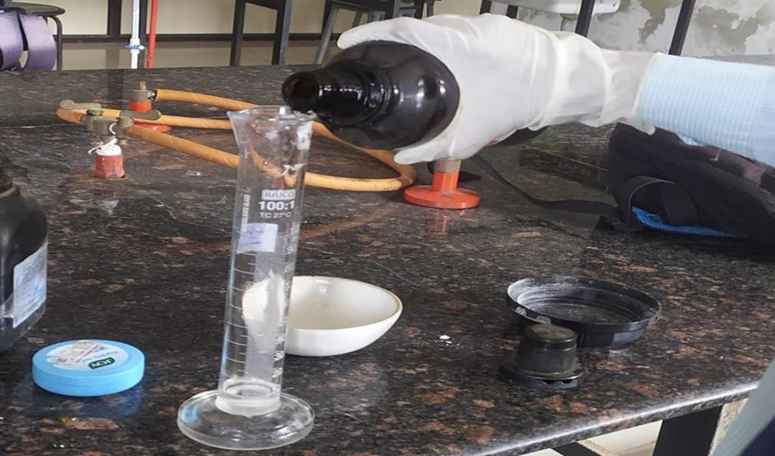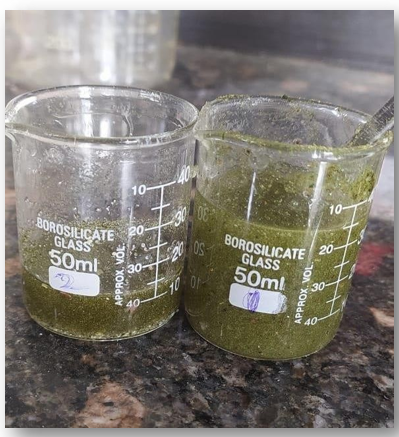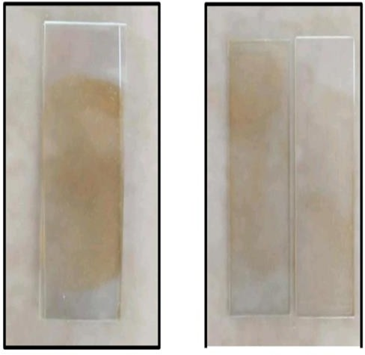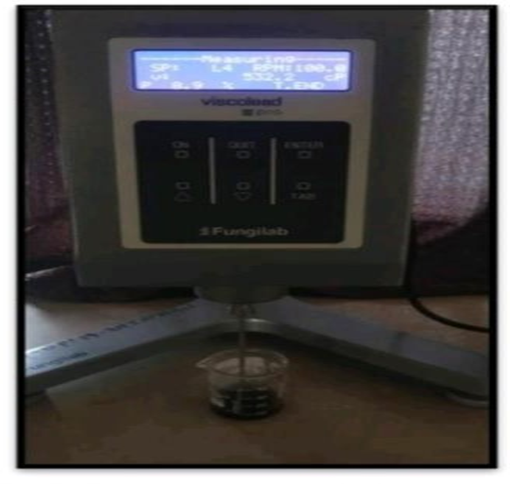Abstract
Antimicrobial gels are essential in combating microbial infections, promoting wound healing, and ensuring hygiene in various medical and personal care applications. This study focuses on the formulation and evaluation of an antimicrobial gel incorporating bioactive agents such as essential oils, metal nanoparticles, or synthetic antibiotics. The gel was assessed for its physicochemical properties, antimicrobial efficacy, and stability. Results demonstrated significant inhibition of bacterial and fungal growth, indicating its potential as a broad-spectrum antimicrobial agent. The formulation exhibited good consistency, spreadability, and long-term stability, making it suitable for topical application. This research highlights the potential of antimicrobial gels in healthcare, emphasizing their role in infection control and therapeutic applications.
Keywords
Herbal antimicrobial gel, Tulsi (Ocimum sanctum), Babool (Vachellia nilotica), Curry leaves (Murraya koenigii), Natural antibacterial agents, Phytochemical formulation, Wound healing, Skin infection, Topical gel, Herbal medicine, antimicrobial activity.
Introduction
For thousands of years, nature has provided a plentiful supply of medicinal compounds in the form of plants. An incredible amount nowadays medications have been identified from these natural sources. Medicinal plants are plants containing inherent active ingredients used to cure disease or relieve pain.[1] According to the World Health Organization (WHO, 1977) “A medicinal
plant” is any plant, in which one or more of its organs contains substances that can be used for the therapeutic purposes or which, are precursors for the synthesis of useful drugs.[1]
What are herbs
An herb is a plant that is valued for qualities such as medicinal properties, flavor, aroma etc. are called herbs
.Herbal Antimicrobial Gel containing Tulsi, Curry Leaves, Babul.
Tulsi -Due to a wide range of medicinal properties, Tulsi has made contribution to the field of science from ancient as also to modern research. Ocimum sanctum belongs to the plant family lamiaceae and it is known as Holy Basil in English and Tulsi in Urdu.[3] Traditionally, Ocimum sanctum is used as medicinal plant. Clinical applications and pharmacological research have revealed that tulsi has antibacterial and antioxidant properties. Tulsi is also advised for the treatment of hypertension, diabetes, bronchitis, skin conditions, diarrhea, and dysentery. [3] The herb Tulsi has been used for years and is frequently referred to as "the elixir of life" since it helps people live longer. Different parts of plant are used in Ayurveda and Siddha Systems of Medicine for prevention and cure of many illnesses and everyday ailments like common cold, headache, cough, flu, earache, fever, colic pain, sore throat, bronchitis, asthma, hepatic diseases, malaria fever, as an antidote for snake bite and scorpion sting, flatulence, migraine headaches, fatigue, skin diseases, wound, insomnia, arthritis, digestive disorders, night blindness, diarrhea and influenza. The leaves are good for nerves and to sharpen memory. Chewing of Tulsi leaves also cures ulcers and infections of mouth.[4]
Curry leaves (Murraya koenigii) belong to the family Rutaceae. Curry leaves are a well-known leaf spice that are used in very small amounts for their distinctive aroma because they contain volatile oil and may help in digestion. These leaves are frequently used to flavor meals in Asian cuisine. [5]
Curry leaves have a number of health benefits, including hepatoprotective, anticancer, antibacterial, antifungal, antioxidant, and anti-diabetic qualities.[5] One of them also has an important role since it possesses a variety of therapeutic and pharmacological properties that inhibit bacteria.[6]
Babul (Vachellia nilotica) belong to family Fabaceae has been used in ancient medicine for the treatment of several diseases, such as diarrhea, dysentery, hemorrhoid, pyorrhea, abdominal aches, sore throat, etc. diabetes, asthma, hypertension. Nilotica, such as catechins, catechol, gallic acid, sitosterol, kaempferol, niloticane, D- pinitol, linoleic acid etc. Even its silver nanoparticle showed good antimicrobial activity. [7] The primary objective of our project is to create an herbal antimicrobial gel composition that may be used for a variety of conditions, including eczema, psoriasis, dry skin, wrinkles, and rashes. And also provide the antibacterial and antifungal property. Additionally, to assessed the formulation and compared their outcome with their standard value. The key ingredient of the of the formulation is Tulsi(Ocimum sanctum), Curry leaves (Murray koenigii) and Babul (Vachellia).
Review Of Literature
1.Yamani, H. A., Pang, et al. 2022. “Antimicrobial activity of Tulsi (Ocimum tenuiflorum) essential oil and their major constituents against three species of bacteria”. A review of the literature suggested that the main components responsible for the antimicrobial activity of Tulsi oil. The essential oil extracted from Ocimum tenuiflorum showed antimicrobial activity against S. aureus and E. coli, but was less active against P. aeruginosa. Tulsi essential oil could be a valuable topical antimicrobial agent for management of skin infections caused by these organisms or as a wound dressing to prevent infection.[9]
2. Irfan, Uma & Ali, Sarah et al. 2021. “The antibacterial effect of curry leaves (Murraya Koenigii)”. A review of the literature suggested M. koenigii has the bioactive potential and it may be the best natural alternative to antibiotic therapy for tested microbes. Therefore, curry leaves could be effectively used as a natural remedy in everyday meal, for the prevention of bacterial infections.
3. Rana, A et al. 2017. “Antimicrobial properties and phytochemical analysis of different extracts of Murraya koenigii”. Litreture explain that Leaves of Murraya contain various bioactive constituents such as steroids, carbohydrates, saponins, glycosides, flavonoids, phenols, alkaloids.study set out to look into antibacterial properties of curry leaves.
4. Victoriya Salomi, M. et al. 2016. “Phytochemical Analysis and Antimicrobial Activity of Four Different Extracts from the Leaves of Murraya koenigii”. Research enlight the study of four different extracts of Murraya Koenigii (Rutaceae) leaves were screened for their phytochemical composition and antimicrobial activity. The present study investigates the qualitative and quantitative analysis of the major phytochemicals in four different extracts of Murraya Koenigii.
5. Roqaiya, Mariyam et al. 2016 “Acacia arabica (Babool)- A Review on Ethnobotanical and Unani Traditional Uses as well as Phytochemical and Pharmacological Properties”. As the pharmacologists are looking forward to develop ne natural sources, development of modern drugs from Acacia arabica can be emphasized for the control of various diseases. It contains a number of phytoconstituents, which are
the key factors in the medicinal value of this plant. It is quite evident from this review that Acacia arabica is an important medicinal herb and extensively all types of medicinal systems.
6. Amita Pandey, Shalini Tripathi et al. 2014. “Concept of standardization, extraction and pre phytochemical screening strategies for herbal drug”. The pharmacopoeial standards in Ayurvedic Pharmacopoeia of India are not adequate enough to ensure the quality of plant materials since the materials received in the manufacturing premises are not in a condition that effective microscopic examination can be done. Therefore chemical, methods, instrumental methods and then layer chromatographic analysis would determine the proper quality of plant material None standardized procedures of extraction may lead to the degradation of the phytochemical present in the plants and may lead to the variations thus leading to the lack of reproducibility.
7. Chaudhari, Pankaj et al.2014. “Formulation and Evaluation of Antifungal herbal gel of Indian traditional Herbs”. Literature evaluate the various parameter of herbal gel formulation and compared their result with standard
8. Viswanad, Vidya et al. 2012. “Development and evaluation of antimicrobial herbal formulations containing the methanolic extract of Samadera indica for skin diseases”. In this literature, formulations showed acceptable physical properties, and compared their result with standard, were compatible with the skin. The in-vitro antimicrobial activity showed that the formulated gel of the methanolic extract of Samadera indica showed comparatively more against the bacterial and fungal species rather than the formulated gel.
9. Aiyalu et al. 2012. “Formulation and evaluation of topical herbal gel for the treatmentof arthritis in animal model”. Anti-arthritic activity of the developed topical herbal gel formulation may be due to the presence of luteolin and apigenin in methanol leaf extracts of Cardiospermum halicacabum and Vitex negundo
10. Sandeep D. et al.2010. “Formulation and Evaluation of Antibacterial Herbal gels of Murraya koenigii Leaves Extract”. From the present investigation, it has been revealed that herbal gels of plant Murraya koenigii leaves extract can be formulated using carbopol940 as polymer with other ingredients and the evaluation of physical parameters shown satisfactory results. From the antibacterial activity it was found that prepared herbal gels of Murraya koenigii leaves extract were significantly active against tested pathogens which were comparable with standard antibiotic. Hence, from the overall results, finally it was concluded that the formulated herbal gels have significant antimicrobial properties and hence will be better, safe and effective than allopathic medications.
Rationale of the Study:
Need of Work: -
Overall, the use of antimicrobial herbal gels is a safe and effective way to protect against harmful microorganisms while promoting overall health and wellbeing. The aim of preparing an herbal antimicrobial formulation is to develop a product thatcan effectively kill or inhibit the growth of harmful microorganisms such as bacteria, viruses, and fungi using natural ingredients. The primary goal of preparing an herbal antimicrobial formulation is to provide a safe, effective, and natural alternative to synthetic antimicrobial agents that can have harmful side effects. Herbal antimicrobial formulations are considered to be safer and less toxic than synthetic antimicrobial agents, making them a popular choice for people who prefer natural products.
Objectives: -
- Reduces the spread of infections: Antimicrobial herbal gel is effective in killing harmful microorganisms on the skin, thereby reducing the spread of infections.
- Promotes wound healing: Some antimicrobial herbal gels contain ingredients that promote wound healing.
- Safe and natural: Antimicrobial herbal gels are made from natural ingredients, making them safe for use on the skin.
- Environmentally friendly: Antimicrobial herbal gels are made from renewable resources and biodegradable ingredients. They do not contain harmful chemicals that can harm the environment.
Plan of Work: -
• Selection of pure drug
1. Tulsi
2. Babul.
3. Curry leaves
• Preparation of Reagents-
1. Collection of Plant Material
2. Preparation of extract
3. Formulation
• Experimental Design-
-
-
- To Prepare And evaluate herbal antimicrobial gel
• Comparative study
• Result & discussion
• Conclusion
• Reference
Drug Profile: -
Tulsi
Synonyms: Holy basil in English, and Tulsi in Sanskrit.
Biological source: Tulsi consists of the fresh and dried leaves of Ocimumspecies like Ocimum Senctum L. And Ocimum basilicum L.
Genus: Ocimum.
Order: Lamiales.
Species: Sanctum.
Family: Lamiaceae.
Chemical constituents: oleanolic acid, eugenol, linalool, carvacrol.
Uses: Antioxidants, anti-inflammatory, anti-allergic. Also used in common cold, headache, cough, flu, earache, fever, colic pain, sore throat, bronchitis, asthma, hepatic disease

Fig 1.1- Leaves of Tulsi Fig1.2- Powder of Tulsi
Curry Leaves
Synonyms: Curry Leaf English, Mitha Neem in Hindi, and Surabhi Nimba in Sanskrit.
Biological source: Curry Leaf consists of the fresh and dried leaves of Murraya koenigii L.
Genus: Murraya.
Order: Sapindales.
Species: Murraya koenigii.
Family: Rutaceae.
Chemical Constituents: Linalool, Geranyl Accetate
Uses: ant diarrheal, antifungal, blood purifying, anti-inflammatory, and anti- depressant agents

Fig 1.3- Curry Leaves Fig 1.4- Curry Leaves Powder
Babul Tree
Synonyms: Acacia nilotica, babol, gum arabic tree.
Biological source: Babul consists of the dried bark of tree Vachellia nilotica L.
Genus: Vachellia.
Order: Fabales.
Species: Vachellia nilotica.
Family: Fabaceae.
Chemical constituents: Calcium, Magnesium, potassium, Tannin, Mallic acid
Uses: Primary application in oral and dental hygiene, burn injuries and management of skin disease.

Fig 1.5- Stem of Babul Fig 1.6- Stem of Babul powder
MATERIALS AND METHODS:
Table 6.1: List of Materials
|
Sr. No.
|
Particular
|
Quantity
|
|
1.
|
Extract of tulsi
|
1gm
|
|
2.
|
Extract of babool
|
1 gm
|
|
3.
|
Extract of curry tree
|
1gm
|
|
4.
|
Carbapol940
|
1 gm
|
|
5.
|
Polyethylene glycol 400
|
10 ml
|
|
6.
|
Ethanol
|
3ml
|
|
7.
|
Methyl paraben
|
0.2gm
|
|
8.
|
Propel paraben
|
0.002gm
|
|
9.
|
EDTA
|
0.003gm
|
|
10.
|
Distilled water
|
100ml
|
|
11.
|
Triethanolamine
|
Quantity sufficient
|
Drgltri Gcyugs and chemicals: Extract of tulsi, babool , curry tree , carbapol 940, Propylene ycol 400, ethanol,methyl paraben,propyl paraben, EDTA distilled water , ethanolamine lassware’s and instruments: Beaker, volumetric flask, china dish, measuring linder, weighing balance, stirrer,
METHODS:
Collection of plant material.
The authentic fresh leaves of Tulsi (Ocimum sanctum L), curry tree (Murraya koenigii), stem ofBabul (Vachellia nilotica) was collected from the surrounding agricultural area of college campus. The collected fresh leaves of each plant were washed under running water and shade dried for one week. After drying plant leaves and stem were coarsely powdered with the help of grinder and prepared into 80 mesh size.
Preparation of extract
Take a 1000 ml beaker, add 50 gm of coarsely powder of dried plant materials was weighed and soaked in 300 ml of distilled water and 25 ml of methanol. Allow to stand for 4-5 days with occasional stirring. Then after the extract was filter and concentrated by using desiccator with thehelp of desiccating agent (calcium oxide) for 4-5 days. Dry extract was then powder with the help of mortor and pestle and stored in well closed container.

Fig 1.7 Aqueous Extraction of Drug
Preparation and formulation.
- Accurately weighed Carbopol 934 was taken in a beaker and dispersed in 50 ml of distilled water.
- Kept the beaker aside to swell the Carbopol for half an hour and then stirring should be done using mechanical/lab stirrer at 1200 rpm for 30 min. Take 10 ml of polyethylene glycol (400) and required quantity of Extract.
- Take 10 ml polyethylene glycol in another beaker and add weighed quantity of Propyl paraben and methyl paraben to it and stirred properly.
- After all Carbopol dispersed, 1 gm extract and preservatives solutions were added with constant stirring.
- Finally, volume made up to 100 ml by adding remaining distilled water and Triethanolamine was added drop wise to the formulations for adjustment of required skin pH (6.8-7) and to obtain the gel at required consistency.

Fig. 1.8 Measurement of Triethanolamine

Fig 1.9 Formulation of Gel
Preliminary- Evaluation test of drug:
- PH determination.
A digital PH meter was used for the determination of pH of the prepared gel formulation.
- Appearance.
A Visual inspection was done in order to check the physical appearance and the homogeneity of the prepared gel formulation.
- Spreadability.
About 1 gram of sample was weighed and place at a center of glass plate and another glass plate was place over it carefully about the glass plate 100 gram weight was placed up on upper slide so
that the formulation between two was pressed uniformly to form a thin layer, the weight was remove and the excess of formulation adhering in to the slide was scrapped off. One of the slide was fixed on which the formulation was placed the time in which upper slide moves over the lower plate was taken as measured of Spreadability. Spreadability is calculated by using the formula.
M- Weight on the slide.
L- Length moves on the slide. T- Time taken.

Viscosity.
Viscosity of gel was measured using a Brookfield viscometer with a spindle number 6 at 100 RPM.
- Skin irritation test.
It was perform on 10 healthy volunteers comprise of both male and female. About one gram of gel preparation were applied on the hand of volunteers and held for a particular period of time. After 2 hour the test area was observe for any visual sign which might be result for skin irritation.
Antimicrobial activity.
Evaluation of Antimicrobial Activity Can be done by using disc plate method. Disc plate Method- Disc diffusion method for antimicrobial susceptibility testing was carried out according to the standard method by Kirby Bauer Sterilize the area with disinfectant and open burner before performing the test. A sterile cotton swab is dipped into the inoculum and remove excess medium by pressing the swab onto the wall of the tube. Swab the surface area of the plate completely by rotating the plate. This technique is called lawn culture or carpet culture. Allow the plates to dry for 5 minutes so that the medium absorbs the inoculum properly. Firstly, sterilize the forceps with alcohol before picking up antibiotic discs. Discs should be placed at a distance of 24mm.Lightly touch each disc with forceps to ensure that it is in good contact to avoid misplacement. Incubate the plate upside down for 24 hours at 37ºC. After 24 hours of incubation, use a metric ruler to measure the zone of inhibition and include the diameter of the disc in the measurement. [19-22]
Antibacterial activity.
Antibacterial activity of herbals formulation is assessed by using bacteria bacillus subtilis with the help of culture media Muller hington agar plate. Incubate the plate upside down for 24 hours at 37ºC.

Fig. 1.10: Spreadability Evaluation

Fig 1.11: Viscosity Evaluation
RESULT AND DISCUSSION:
Observation table:
Table 7.1:
|
Parameter
|
Observation
|
|
PH
|
6.4
|
|
Appearances
|
Good
|
|
Homogeneity
|
Good
|
|
Spreadibility
|
10 sec
|
|
Viscosity
|
4300 pa.s
|
Preliminary study: Identification Test
Table 7.2
|
Sr.
No.
|
Physical properties &test
|
Description
|
|
1.
|
Physical state
|
Semi solid
|
|
2.
|
Color
|
Green
|
|
3.
|
Odor
|
Pungent
|
|
4.
|
Solubility
|
Soluble in acetone
|
|
5.
|
Melting Point
|
70'C
|
CONCLUSION
Literature from more than a thousand years ago describes how medicinal herbs are used in conventional medicine. 70%–80% of people utilize herbal medicine as their primary form of healthcare. From the study we can say that Tulsi, curry leaves, and Babul These herbs demonstrate to be certainly beneficial as a supplement to mechanical therapy in the prevention and treatment of tropical skin illness. Also serve a multipurpose product that use in rashes, dry skin, irritation and local infection etc. From the study we can conclude that, Herbal antimicrobial gel containing Tulsi, curry leaves, Babul was successfully prepared and evaluated. From the evaluation of the herbal antimicrobial gel, we can conclude that formulation F1 has a potent antimicrobial activity evaluate against the bacteria bacillus subtilis and fungi candida albican.
REFERENCES
-
-
-
- USP32–NF27 [2008]: United States Pharmacopoeial convention, INC, Rockville,MD., 2181.
- Amidon GL, Lennernas H, Shah VP, Crison JR. A theoretical basis for a biopharmaceutic drug classification: the correlation of in vitro drug product dissolution and in vivo bioavailability. Pharm Res. 12(3):1995; 413–20.
- Marques M. Dissolution media simulating fasted and fed states. Dissolution Technologies 11(2):2004; 16.
- EkaratJantratid and Jennifer Dressman, Biorelevant Dissolution Media Simulating the Proximal Human Gastrointestinal Tract: An Update, Dissolution Technologies | AUGUST 2009, 21-25.
- N. Parrott, V. Lukacova, G. Fraczkiewicz, and M. B. Bolger, Predicting Pharmacokinetics of Drugs Using Physiologically Based Modeling— Application to Food Effects, The AAPS Journal, Vol. 11, No. 1, March 2009, 45-53
- S. S. De Buck, V. K. Sinha, L. A. Fenu, M. J. Nijsen, C. E. Mackie, and R. A. H. J. Gilissen. Prediction of human pharmacokinetics using physiologically based modeling: a retrospective analysis of 26 clinically tested drugs. Drug Metab. Dispos. 35(10) (2007).
- Dressman, J. B.; Vertzoni, M.; Goumas, K.; Reppas, C. Estimating drug solubility in the gastrointestinal tract. Adv. Drug Deliv. Rev. 2007, 59 (7), 591–602.
- Sandra Klein, The Use of Biorelevant Dissolution Media to Forecast the In Vivo Performance of a Drug, The AAPS Journal, Vol. 12, No. 3, September 2010, 397-407.
- Horter D, Dressman JB. Influence of physicochemical properties on dissolution of drugs in the gastrointestinal tract. Adv Drug Del Rev. 25(April):1997; 3–14.
- Rana, a. (2022). Antimicrobial properties and phytochemical analysis of different extracts of murraya koenigii. J pharmacogn phytochem, 11(6), 1–06. Victoriya salomi, m., and manimekalai, r. 2016. Phytochemical analysis and antimicrobial activity of four different extracts from the leaves of murraya koenigiiint.j.curr.microbiol.app.sci. 5(7): 875-882.
- Roqaiya, mariyam et al. “acacia arabica (babool) - a review on ethnobotanical and unani traditional uses as well as phytochemical and pharmacological properties.” International journal of pharmaceutical and phytopharmacological research 4 (2017): 315-321.phytochemical screening strategies for herbal drug. J pharmacogn phytochem 2014;2(5):115-119.
- Chaudhari, pankaj & mahajan, sachin & chaudhari, pankaj & patil, prakash. (2021). Patil. Formulation and evaluation of antifungal herbal gel of indian traditional herbs. Advances in bioresearch. 12. 81-85. 10.15515/abr.09764585.12.2.8185.
- Viswanad, vidya et al. “development and evaluation of antimicrobial herbal formulations containing the methanolic extract of samadera indica for skin diseases.” Journal of advanced pharmaceutical technology & research vol. 3,2 (2012) : 106-11.
- Aiyalu et al. 2016.formulation and evaluation of topical herbal gel for the treatment of arthritis in animal model. Brazilian journal of pharmaceutical sciences, 52(3),
- p d.Sandee S, prashant nayak, jobin jose, rishal relita m, sumana d. R.. Formulation and evaluation of antibacterial herbal gels of murraya koenigii leaves extract. Research j. Pharm. And tech. 2017; 10(6): 1798-1801.
- Aiyalu et al. 2016.formulation and evaluation of topical herbal gel for the treatment of arthritis in animal model. Brazilian journal of pharmaceutical sciences, 52(3), 493–507.
- Sandeep d. S, prashant nayak, jobin jose, rishal relita m, sumana d. R.. Formulation and evaluation of antibacterial herbal gels of murraya koenigii leaves extract. Research j. Pharm. And tech. 2017; 10(6): 1798-1801
- Zaidan, M. R., Noor Rain, A., Badrul, A. R., Adlin, A., Norazah, A., & Zakiah, I. In vitro screening of five local medicinal plants for antibacterial activity using disc diffusion method. Trop biomed, 22(2), 165-170;2005.
- World Health Organization Expert Committee on Biological Standardization. Technical report series 822. W.H.O., Geneva.,1992.
- CLSI: Clinical and Laboratory Standards Institute. Approved standard M100S22. Performance standards for antimicrobial susceptibility tests, 10th ed. CLSI, Wayne, Pa., 2012.
- EUCAST: European Committee on Antimicrobial Susceptibility Testing. EUCAST QC Tables V1.2. 2010. 41. Kumar PS, et al. Medicinal uses and pharmacological properties of Moringa oleifera. Int J Phytomed.,2010


 Sanjivani Talekar*
Sanjivani Talekar*









 10.5281/zenodo.15221266
10.5281/zenodo.15221266